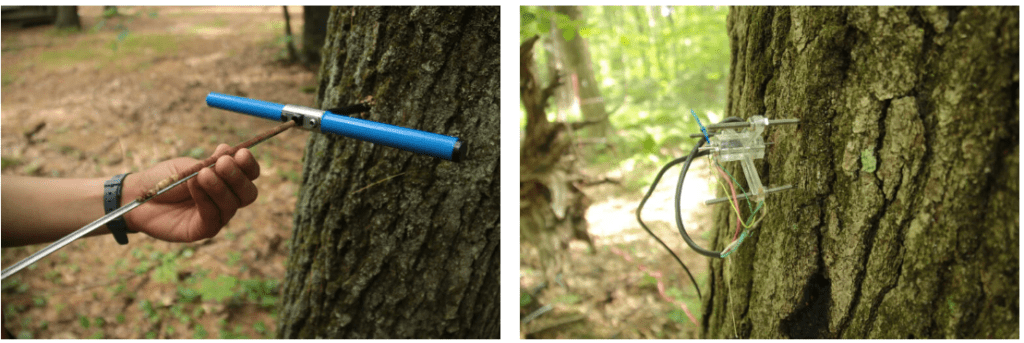
If you could talk to a tree, what would it say? Probably, it would be something like this:
“Yesterday, a big rain soaked the soil and my bark. My trunk swelled in diameter! After the sun dries things out for a while, my trunk might even shrink a bit.”
“The last 2 days were extremely hot for August. When is this heatwave going to end?”
Those are “quotes” extracted from the social profile of the Harvard Forest Witness Tree, the oldest known living organism on social media.
Technology, trees, and social media
The red oak at the Harvard Forest in Petersham has been tweeting as @awitnesstree since July 17, 2019. The project was launched by post-doctoral fellow Tim Rademacher, who installed sensors and cameras on and around the tree, then linking the sensor array to the rich Harvard Forest data archive, adding 55+ years of climate perspective to the tree’s outputs.

“I was struck by the amount of technology that goes into researching one red oak, and trees in general,” says Shawna Greyeyes, a summer intern in the 2019 Harvard Forest Research Program in Ecology who developed the Witness Tree website and is @awitnesstree’s ghostwriter. “There’s a great opportunity here to introduce people to this important science, in language they can hopefully understand, and also connect with.”
Rademacher then built a custom program that translates sensor information into messages for Facebook and Twitter.
“We’ve done the work as a team to equip the tree with a voice, which we decided made the most sense in the first person, and even with a personality, in order to make it relatable to a larger audience,” said Rademacher. “But most importantly, our Witness Tree is an objectively data-driven account, which I expect will amplify messages of climate change. But we don’t decide what gets posted, the tree does.”

The branched educator
At 26 meters (85 feet) tall, the oak stands taller than most trees around it, being one of the most senior trees in its community, at around 110 years old. Much of the forest around it was flattened in a fierce hurricane that wailed through the forest in 1938. But these days, the tree has different problems.
Since its launch, the red oak’s Twitter channel has garnered over 10,000 followers, sharing regular updates regarding its activities and the environmental conditions around it. Oftentimes, it tweets about the temperatures and precipitation it experiences, and while the past few days have been very wet, the average is telling of the effects of climate change.
Temperatures in Massachusetts have risen almost 3.5°F (2°C) since the beginning of the 20th century, and the number of hot days (and nights) has been rising considerably since 2010. In addition, Massachusetts (like most places on the globe) is increasingly impacted by intense weather patterns, ranging from drought to flooding from surges of coastal waters
From the tree’s perspective of over a century, these past few decades are weird. It’s hotter and drier than usual, and it’s only getting worse. It’s hard for species to adapt, and the Witness Tree is an important educator, reminding us that climate change is relentless and often insidious.
The tree is a storied one (in 2017, it came into the spotlight as the focus of a popular book about climate change, Witness Tree, written by journalist Lynda Mapes), but it’s not exactly a special one. In fact, it was chosen for this project specifically because it’s not unusual.
This is exactly why its stories are so important: because they’re the stories of millions and millions of trees from around the world, all of which are facing the effects of man-made climate change.
Since preindustrial times, temperatures have risen globally by about 1°C, but that doesn’t mean a neat, uniform 1°C increase. We’re seeing more extreme weather events, just like the tree, and more hot, dry days — just like the tree. We may not see it every day, but the long-term trends are clear: the world is getting hotter, and we’re causing it. Perhaps, sometimes, we need a tree to remind us of that.









